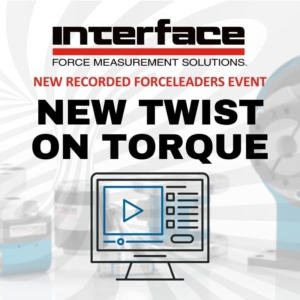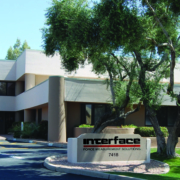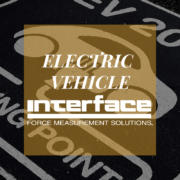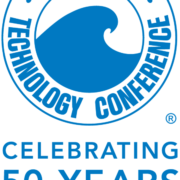Recap of New Twist on Torque
 In our latest virtual event New Twist on Torque, Randy White and Keith Skidmore shared valuable insights and tips using this type of sensor. With more than 50 different types of torque transducers available at Interface, this webinar highlighted the differences, specifications, use cases and integration advice from our experts.
In our latest virtual event New Twist on Torque, Randy White and Keith Skidmore shared valuable insights and tips using this type of sensor. With more than 50 different types of torque transducers available at Interface, this webinar highlighted the differences, specifications, use cases and integration advice from our experts.
The ForceLeaders webinar started off with a quick rundown on the history of torque from the first dynamometers measuring the torque and RPMs of motors to the revolutionary Interface AxialTQ. In fact, you can now see how this rotary torque transducer is actually being used in today’s advanced engine dynamometers solution here. The conversation quickly lead to multiple design options and progressed to vital integration tips, considerations and common questions.
By definition, torque transducers convert a mechanical input of torque to an electrical output signal where the signal is directly proportional to the torque input. They consist of a metal spring element like a load cell. The strain gages are bonded to the flexure in a Wheatstone bridge configuration. As torque is applied to the sensor, bending or shear strain in the gaged area, it causes the strain gages to change resistance and generate an output voltage signal proportional to torque. You can read more about torque basics in our Torque Transducers 101 post.
Throughout the event, our experts shared important know-how in using the various types of transducers, including rotary, reaction, miniaturized and even custom-built products. Reaction sensors, also referred to as static, measure torque without rotating. A rotary sensor, also called dynamic, rotates as part of a system. It is merely a reaction sensor that’s allowed to rotate. And yes, you can customize torque transducers to fit your exact requirements. You can see all our torque products here.
Keith detailed four important considerations related to capacity: drive service factors, load service factors, stopping and starting conditions and extraneous loading. There was a robust discussion about fixed and floating mounting options and the importance of couplings. Randy highlighted all the products available and also gave a great recap of several real use cases across various several industries including energy markets, automotive and vehicles, robotics and more.
Be sure to watch the entire event for an abundance of firsthand knowledge and expertise based on working with thousands of customers using torque transducers all types of applications.
WATCH THE ENTIRE RECORDED NEW TWIST ON TORQUE EVENT
There is a lot of information packed in this online event including ten integration tips that will help you define your requirements to get the right sensor for the job. Be sure to check out the FAQs and innovative application highlights, where we showcase everything from ATV and Mountain Bike Testing to Poultry Feeders and Hydrogen Power Generation. You can see all our application notes here.
The topics discussed during this recorded event include:
- The Evolution of Torque Measurement
- Interface Torque Transducer Specifications and Designs
- Useful Application Tips when Using Torque Transducers
- Review of Couplings and Instrumentation
- Customization and Calibration
- Industry Use Cases
- Frequently Asked Questions
You can watch all of our events on our Interface YouTube channel.








